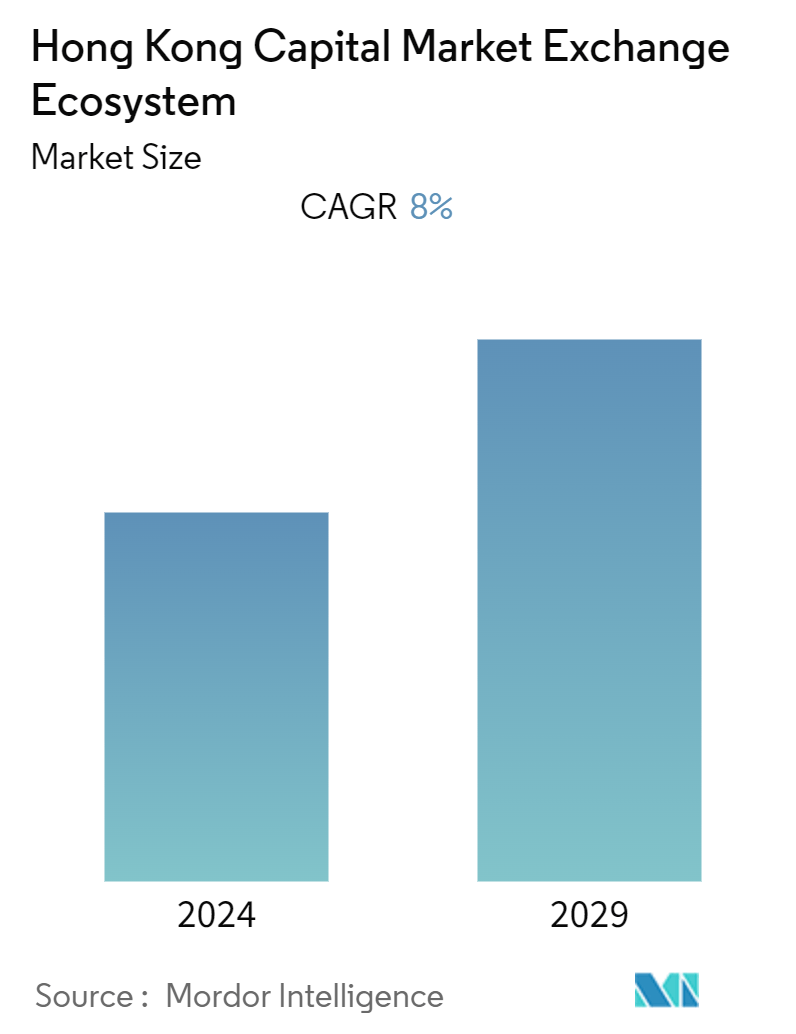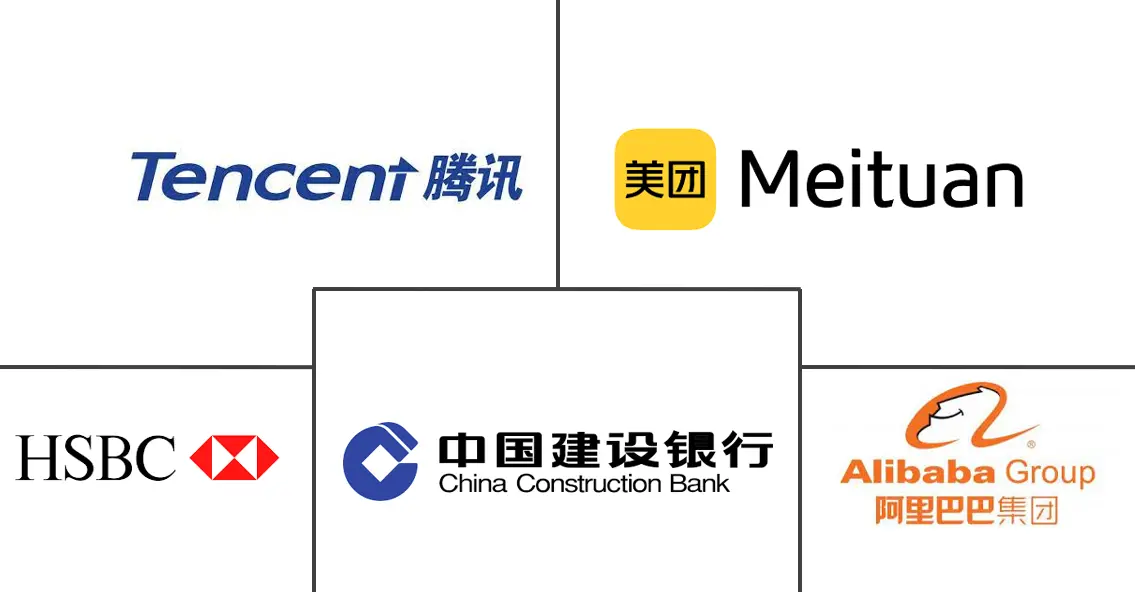Market Size of Hong Kong Capital Industry Exchange Ecosystem

| Study Period | 2020 - 2029 |
| Base Year For Estimation | 2023 |
| Forecast Data Period | 2024 - 2029 |
| Historical Data Period | 2020 - 2022 |
| CAGR (2024 - 2029) | 8.00 % |
| Market Concentration | Low |
Major Players
*Disclaimer: Major Players sorted in no particular order |
Hong Kong Capital Market Analysis
The Hong Kong Capital Market Exchange Ecosystem Industry is expected to register a CAGR of 8% during the forecast period.
Trading other financial instruments, such as derivative contracts like options, different loans and other debt instruments, and commodity futures, can be done on the capital markets. Certain capital markets are directly accessible to the general public, while others are only accessible to major institutional investors. Private trading takes place at very fast speeds across secured computer networks, primarily between large institutions that engage in high-volume trading. A sizeable amount of the capital market trade volume comes from the stock and bond markets.
Primary and secondary markets make up the capital markets. Today's primary and secondary markets are primarily computer-based electronic marketplaces. The main marketplaces are where newly issued bonds and equities are exchanged. These are used by governments and businesses to raise capital; investors purchase directly from the issuer. Companies frequently issue both bonds and stock, whereas governments exclusively issue bonds.
These securities are known as IPOs or primary offerings. A firm that goes public sells its bonds and equities to institutional and large-scale investors, including sovereign wealth funds, mutual funds, hedge funds, and pension funds. Conversely, the markets where existing stocks and bonds are traded are known as the secondary markets. Here, a far greater range of assets is available. The secondary market is not involved with issuing corporations.
Hong Kong Capital Industry Segmentation
Capital markets play a significant role in economics as they supply funding for long-term investment and improvement, which contributes to economic growth. A complete background analysis of the Hong Kong Capital Market Exchange Ecosystem is covered in the report, which includes an assessment of the economy, a market overview, market size estimation for key segments, emerging trends in the market, market dynamics, and key company profiles.
The Hong Kong capital market exchange ecosystem is segmented by type of market, financial product, and investors. By type, the market is sub-segmented into primary market and secondary market. By financial product, the market is sub-segmented into debt and equity. By investors, the market is sub-segmented into retail investors and institutional investors.
The report offers market size and forecasts for the Hong Kong Capital Market Exchange Ecosystem in value (USD) for all the above segments.
| By Type of Market | |
| Primary Market | |
| Secondary Market |
| By Financial Product | |
| Debt | |
| Equity |
| By Investors | |
| Retail Investors | |
| Institutional Investors |
Hong Kong Capital Market Exchange Ecosystem Size Summary
The Hong Kong Capital Market Exchange Ecosystem is poised for significant growth, driven by its role as a pivotal trade center and its integration with mainland Chinese markets. The ecosystem encompasses both primary and secondary markets, primarily operating through electronic platforms. These markets facilitate the issuance and trading of securities, including stocks and bonds, which are crucial for capital raising by governments and businesses. The Hong Kong Stock Exchange, in particular, has become a major hub for new public offerings, attracting both domestic and international investors. The region's business-friendly environment and strategic proximity to China make it an attractive destination for companies looking to access Chinese markets while benefiting from a robust regulatory framework that supports foreign direct investment.
The competitive landscape of the Hong Kong Capital Market Exchange Ecosystem is characterized by intense rivalry and fragmentation, with major players like Tencent Holdings, Alibaba Group, and HSBC Holdings actively engaging in strategic initiatives to enhance their market position. These companies are leveraging partnerships, technological advancements, and mergers and acquisitions to expand their offerings and streamline operations. The ecosystem's growth is further supported by the presence of global financial institutions, such as Credit Suisse, which continue to operate in Hong Kong despite broader corporate changes. The market's dynamism is underscored by significant foreign investments in sectors like real estate and professional services, reflecting Hong Kong's status as a leading financial hub in Asia.
Hong Kong Capital Market Exchange Ecosystem Market Size - Table of Contents
-
1. MARKET DYNAMICS AND INSIGHTS
-
1.1 Market Overview
-
1.2 Market Drivers
-
1.3 Market Restraints
-
1.4 Industry Attractiveness - Porter's Five Forces Analysis
-
1.4.1 Bargaining Power of Buyers
-
1.4.2 Bargaining Power of Suppliers
-
1.4.3 Threat of New Entrants
-
1.4.4 Threat of Substitutes
-
1.4.5 Intensity of Competitive Rivalry
-
-
1.5 Impact of COVID-19 on the Market
-
1.6 Insights on Technological Innovations in the Market
-
-
2. MARKET SEGMENTATION
-
2.1 By Type of Market
-
2.1.1 Primary Market
-
2.1.2 Secondary Market
-
-
2.2 By Financial Product
-
2.2.1 Debt
-
2.2.2 Equity
-
-
2.3 By Investors
-
2.3.1 Retail Investors
-
2.3.2 Institutional Investors
-
-
Hong Kong Capital Market Exchange Ecosystem Market Size FAQs
What is the current Hong Kong Capital Market Exchange Ecosystem Industry size?
The Hong Kong Capital Market Exchange Ecosystem Industry is projected to register a CAGR of 8% during the forecast period (2024-2029)
Who are the key players in Hong Kong Capital Market Exchange Ecosystem Industry?
Tencent Holdings Ltd., Alibaba Group Holding Ltd. - SW, Meituan - W, China Construction Bank Corporation - H Shares and HSBC Holdings plc are the major companies operating in the Hong Kong Capital Market Exchange Ecosystem Industry.

